How the Telegraph Went From Semaphore to Communication Game Changer
Samuel Morse was an artist by trade, but to the world he’s best known for connecting the dots —and dashes— that forever changed the way we communicate
/https://tf-cmsv2-smithsonianmag-media.s3.amazonaws.com/filer/20131011082040telegraph-470.jpg)
Today, we collapse space and time without even thinking about it. With a touch of our fingers, we can instantly extend ourselves into the ether and around the world from the backseat of a station wagon. We have become a culture of conjurers and time lords. Ok, that might be overstating things a bit, but you get the idea.
The wondrous information and communication technologies that define our age have their origins in some of the most basic of scientific principles and were first manifest in the 18th century electric telegraph. But that too had a precedent. Originally, the word “telegraph” –literally “to write at a distance”– referred to a relay communication system developed in 18th-century France by the Brothers Chappe. The Chappe semaphore telegraph consisted of a series of towers topped with three rotating arms or panels that could be moved into nearly 200 standard positions, each assigned a unique value or meaning. Messages could be relayed across vast distances by transmitting from one tower or hill (hence, “Telegraph Hill”) to another up to 15 miles away; operators used telescopes to observe and decode the message before doing the hard work of cranking their own semaphore panels into place to relay the message further down the line.
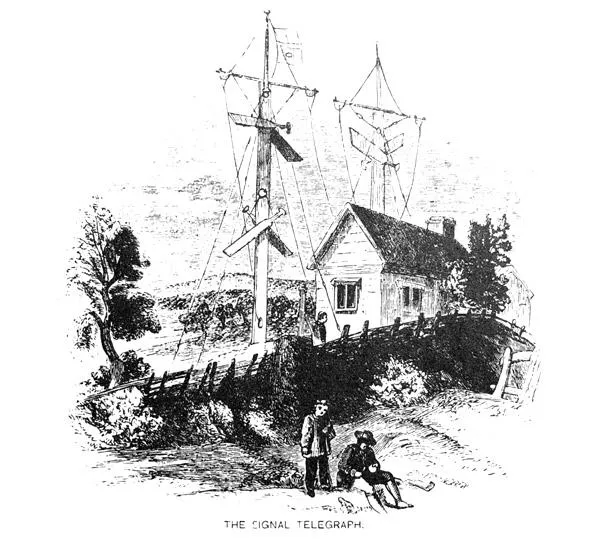
It was the fastest way to send messengers and in the early 19th century a young but battle-weary American government offered $30,000 (roughly $440,000 today) to anyone who could build a semaphore telegraph system spanning 1,000 miles. It seemed an impossible task. The challenge was largely ignored and promptly forgotten – but never rescinded. Years later, in 1837, Samuel Morse would hear of the offer and approach Congress with an invention that must have seemed like magic or some sort of hoax.
Though best known today for the coded system of dots and dashes that (perhaps unjustly) bears his name, Samuel Finley Breese Morse (1791-1872) started out as a promising painter. By 1815, the young Morse was making a solid living as a portraitist. As is wont to happen for young artists (not to mention young countries), Morse’s fortunes rose and fell dramatically for the next few years as he traveled back and forth between America and Europe, eventually painting The Louvre, which he hoped would be a masterpiece of the caliber never seen by American audiences. In 1832, Morse boarded The Sully and set sail for his return to America, but during the month-long voyage, his life would change course dramatically.
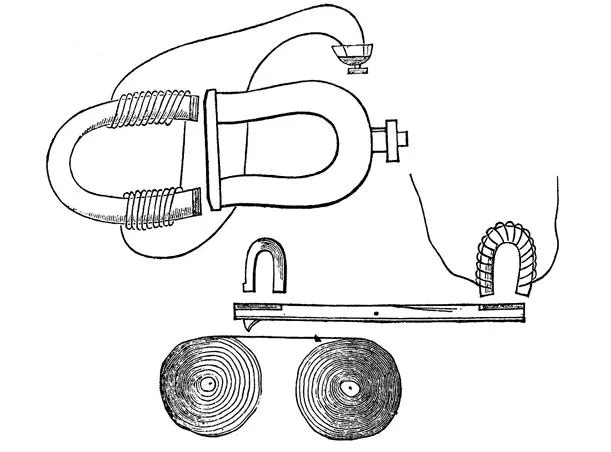
Aboard the Sully, Morse had a conversation with a fellow passenger about recent experiments in electromagnetism. Although he was completely ignorant of the scientific principles behind the discovery, he became fascinated by the possibility of sending coded messages over a wire. Morse made a few impossible sketches describing a system of an electromagnet and basic stylus to transcribe a primitive code and left the ship determined to realize his invention, reportedly telling the captain as he departed, “If you ever hear of the ‘telegraph’ as one of the wonders of the world, remember that it was invented on the Sully.”
Over the next five years, Morse would slowly develop his idea while continuing to paint, teach at New York Univeristy, and flirt with poverty. Unsurprising given Morse’s complete naiveté reading electricity, there was a lot of trial and error in the early development of the telegraph and, although popular histories tend to perpetuate the myth of the individual genius who single-handedly changes the world, there were many other people were critical in the development of the telegraph.
Leonard Gale, a chemistry instructor at NYU, taught a struggling Morse how to make a basic electromagnet and helped him assemble a primitive apparatus that could send a signal of 1,000 feet. Joseph Henry, a pioneer in electromagnetics, developed the electric relays that made it possible for telegraph signals to travel great distances (and later became the first Secretary of the Smithsonian.) Some the greatest contributions came from Alfred Vail, Morse’s assistant and the son of one of his benefactors, who was largely responsible for developing the coded system of dots and dashes that would ultimately bear Morse’s’ name.
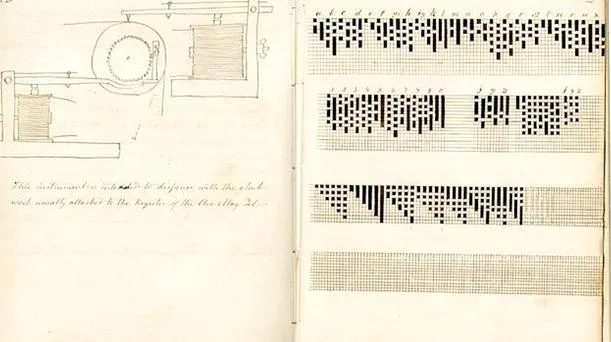
By 1837 Morse had completed a prototype of the device he first sketched aboard the Sully. Built from one of his easels, it was far too large and incredibly rudimentary, but it worked.
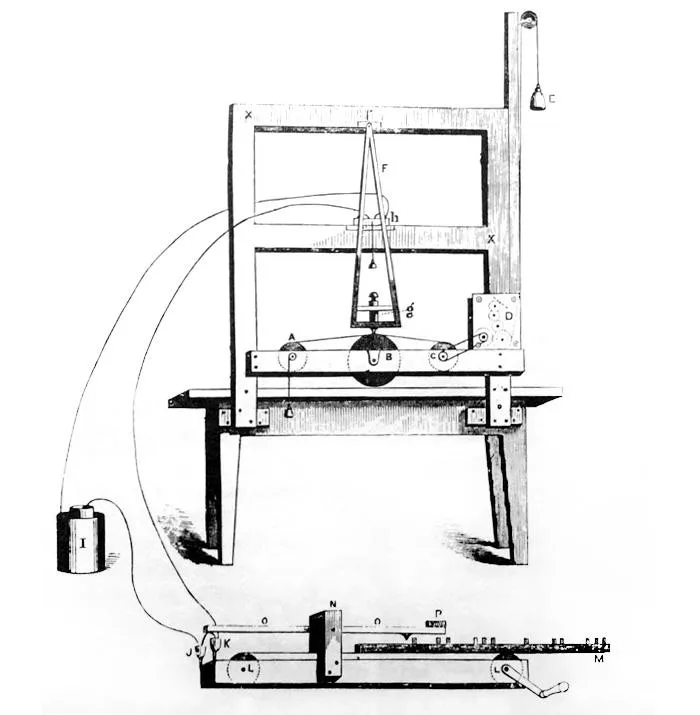
The prototype was really just a proof-of-concept used to get Morse the $30,000 offered by the government long ago. Congress begrudgingly funded the project and in 1844 the famous first telegraph message traveled almost instantaneously across the 40 miles between Baltimore and Washington D.C.: “What Hath God Wrought.” America had entered the information Age. The telegraph exploded. Within the next 10 years, 23,000 miles of telegraph wire crossed the country and the made a significant impact on westward development. New business emerged and new jobs were created to install and maintain the system of wires.

Though Morse’s name ended up on all the patents, it was the inventive and unaccredited Vail who came up with the familiar telegraph key and was responsible for miniaturizing the machine to make it practical. Over the course of their collaboration, Morse and Vail developed several other designs for a telegraph and spent a lot of time in court, defending their patents from infringement.
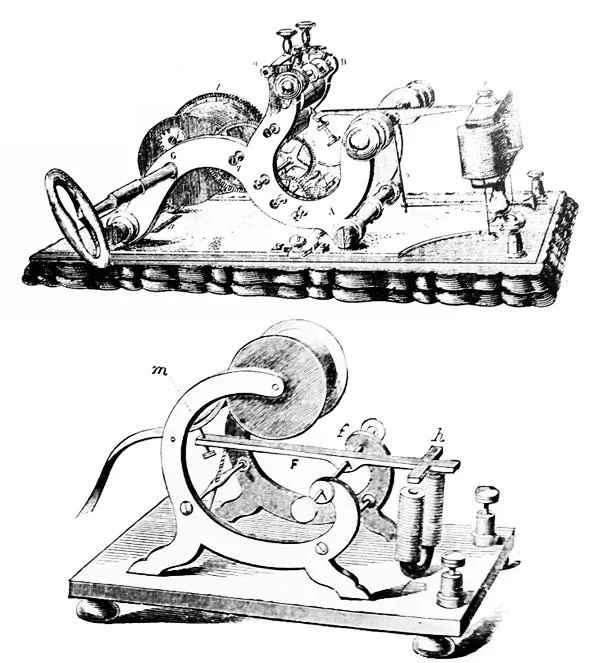
Other inventors and designers always found ways around Morse’s patents, creating improved, or at the very least, idiosyncratic, versions of the telegraph.
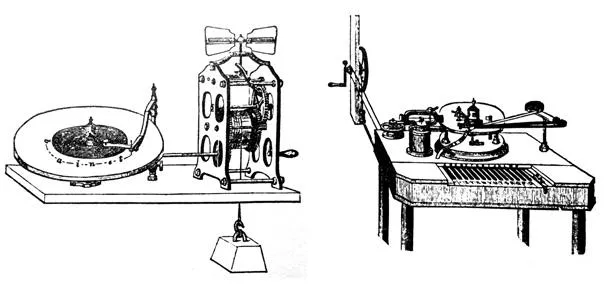
Various machines were developed and abandoned, operating companies were formed and disbanded, and lines were built and broken, but the telegraph lived on, slowly connecting the country and significantly aiding westward expansion. By the 1860s, most of these patents had been bought by the upstart Western Union Telegraph Company, who combined the best aspects of every telegraph design and gave order to the now transcontinental telegraph network. For the first time, space and time collapsed in 19th century America and suddenly great distances didn’t seem so great.
/https://tf-cmsv2-smithsonianmag-media.s3.amazonaws.com/accounts/headshot/Jimmy-Stamp-240.jpg)
/https://tf-cmsv2-smithsonianmag-media.s3.amazonaws.com/accounts/headshot/Jimmy-Stamp-240.jpg)